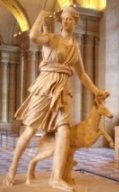 Artemis is a goddess. The meaning of her name is not clear but it may mean 'Protector'.
Artemis is a goddess. The meaning of her name is not clear but it may mean 'Protector'.
Artemis is the goddess of the moon, a virgin, a hunter, and protector of animals, the forest, children, and women in childbirth.
According to ancient Greek mythology, Artemis was the daughter of
Zeus and Leto, twin sister of the sun god Apollo. According to other ancient myths, she was the daughter of Persephone and Hades.
Artemis represents to me all that is wild, creative, and
untamed. She is the goddess not only of hunting, but of wild things
and animals, of the moon, and of childbirth and children. In my opinion, she must be one of the oldest Goddesses, since
the Neolithic Goddess dating back to 30,000 years or more ago was
called 'The Lady of the Animals' before she even had a name. She is the goddess of all the transformative,
dangerous, exciting moments in life.
This image shows Artemis as the Greeks and Romans saw her. This Roman copy of a Greek statue by Leokhares, dating from the 4th century BCE, depicts Artemis hunting. She is in motion and accompanied by a deer. She is in the act of reaching over her shoulder to retrieve an arrow from the quiver on her back.
Although most of the myths associated with Artemis come to us from the Greeks, her greatest temple was in Ephesus, in what is now Turkey. Once one of the Wonders of the Ancient World, it was where she was worshipped as the goddess of fertility. The art there shows her not as the
fleet-footed huntress of Greek art, but as a exotic and serene woman,
her hands raised in blessing, her body draped with strange rounded
shapes. No one really knows what these shapes are supposed to be. For
years, they were assumed to be multiple breasts; then it was thought
that they were bulls' testes; then eggs; nowadays it's generally
accepted that, whatever they are, they are intended to be fertility
symbols.
 Her inherent contradictions intrigue me; she is goddess of animals
but also of hunting; goddess of fertility but also a virgin;
beautiful and kind-hearted but also very powerful, independent, and mysterious.
Her inherent contradictions intrigue me; she is goddess of animals
but also of hunting; goddess of fertility but also a virgin;
beautiful and kind-hearted but also very powerful, independent, and mysterious.
Artemis had much in common with several other goddesses. Most famously she is identified with the Roman goddess Diana, but she's spoken of in the same breath as Egypt's Bast and Isis; the Etruscan Artume; the Phoenician Astarte; the Babylonian Ishtar, Inanna, and Tiamat; and the Cretan Ariadne.
Michael Lombard writes: "It strikes me that the answer to the apparent contradictions regarding the true identity of Artemis may lie in the fact that she may not merely be a Lunar goddess but a goddess relating to a particular phase of the Moon, namely the full Moon, as it operates in a particular sign of the zodiac, namely Aquarius. Her guardianship of both childbirth and children may simply be as result of reflex action from the opposite sign of Leo, both of which come under that sign. Leo is the sign of the Sun and therefore the Moon at full reflects the full creative power of the Sun in the female principle, which is the Moon. Her love of freedom, wild animals and nature in general are symbolic of the full Moon in Aquarius, The high water imagery of Artemis at Mount Olympus is also symbolic of Aquarius, the water carrier. But Artemis may well represent the full moon in any sign."
Send me your thoughts on Artemis and I'll add them here!
Here are some images of Artemis, both ancient and modern, plus images of a couple of the many places where she was worshipped. Click on a thumbnail to see a larger version. All images are © their original creator.
 Millions visit Athena's Parthenon in Athens; Artemis' temple in Ephesus reputedly surpassed it in size, beauty and fame. Sadly, only one column now stands.
Millions visit Athena's Parthenon in Athens; Artemis' temple in Ephesus reputedly surpassed it in size, beauty and fame. Sadly, only one column now stands.
 Artemis as the late great Susan Seddon Boulet depicted her.
Artemis as the late great Susan Seddon Boulet depicted her.
 Artemis's image stamped in clay on the seal of a wine container.
Artemis's image stamped in clay on the seal of a wine container.
 A Greek image of Artemis from her sanctuary at Vravrona. Again, she is in motion, beckoning to her brother Apollo and mother Leto.
A Greek image of Artemis from her sanctuary at Vravrona. Again, she is in motion, beckoning to her brother Apollo and mother Leto.
 A carving decorating the Siphnian Treasury at Delphi, Greece. Aphrodite, Artemis (center), and Apollo are shown seated, viewing the battles of the Trojan War.
A carving decorating the Siphnian Treasury at Delphi, Greece. Aphrodite, Artemis (center), and Apollo are shown seated, viewing the battles of the Trojan War.
 Artemis as depicted by artist Boris Vallejo.
Artemis as depicted by artist Boris Vallejo.
 A Greek bronze votive statue of Artemis, dating back to 500 BCE. She is shown holding a bow in one hand and probably held an arrow or arrows in the other.
A Greek bronze votive statue of Artemis, dating back to 500 BCE. She is shown holding a bow in one hand and probably held an arrow or arrows in the other.
 The ruins of Vravrona mark a sanctuary in the wilderness.
The ruins of Vravrona mark a sanctuary in the wilderness.
 Artemis with swastikas (an ancient symbol of the sun), birds, bulls and other animals, from a Greek vase painting.
Artemis with swastikas (an ancient symbol of the sun), birds, bulls and other animals, from a Greek vase painting.
 Artemis, wearing jewels and fully armed with spears and arrows, watches as Iphigenia prepares to be sacrificed. From a Greek vase dated circa 400 BCE.
Artemis, wearing jewels and fully armed with spears and arrows, watches as Iphigenia prepares to be sacrificed. From a Greek vase dated circa 400 BCE.
 Winged Artemis, flanked by a deer and another animal (possibly a wolf or a lion). From a Greek vase dated circa 500 BCE.
Winged Artemis, flanked by a deer and another animal (possibly a wolf or a lion). From a Greek vase dated circa 500 BCE.
 Artemis, wearing a crown, feeds a snake. From a Greek vase dated circa 500 BCE.
Artemis, wearing a crown, feeds a snake. From a Greek vase dated circa 500 BCE.
For more images of Artemis, try the Artemis Gallery, Google image search; this Artemis In Western Art page put together by the University of Haifa Library; or the Perseus Sculpture Catalog. This academic art collection has a keyword-searchable database containing dozens of ancient depictions of Artemis on vases, reliefs, and sculptures. Each entry has detailed background information, too.
The best overview of the myths surrounding Artemis I've found is by Ailia Athena.
Artemis, an essay, by Carla Osborne. A fascinating overview of the history of Artemis.
Read the wonderful poem At Ephesus by Jessica Montgomery, inspiration for this website and a lot more besides. :)
Read a wonderful Litany to Artemis by Underflow.
Click here to read my favourite excerpts about Artemis from ancient writers.
An excellent resource on goddesses from a myriad of cultures, including a specific resource on Artemis and one on Artemis' shadow side, Diana can be found at Thalia Took's site, which apart from some delightful art, houses OGOD, a.k.a. the Obscure Goddess Online Directory! Check it out; it's fabulous.
Melissa Coffey gave this paper to a conference on Images of Women in the Ancient World: Issues of Interpretation and Identity. It has an useful reading list appendix.
Many reference sites have pages on Artemis. A sampling: Encyclopedia Mythica, Classical Myth, Wikipedia, About.com, Archaeonia.com, Mythography, and Theoi.com.
Antemiss presents a choice page called THe eVeR MiGHTY, eVeR CooL GoDDeSS aRTeMiS....
Many sacred sites are dedicated to Artemis. Here are notes on just a few.
"Artemis was [the] goddess of the edges and boundaries, between culture and civilization, virginity and marriage, war and peace, births and deaths. At any time of transition from one state to another, you were in the powerful Artemis' domain," says deTraci Regula, introducing the fascinating site of Vravrona, Greece. Also known as Brauron, this off-the-beaten-track site contains the ruins of a temple to Artemis, a lovely stoa, a sacred spring, a heroon (shrine) to founding priestess Iphigenia and the remains of her tomb, and a museum loaded to the gunnels with beautiful statuary and artifacts.
The Temple of Artemis at Ephesus, Turkey, was once one of the Seven Wonders of the World. According to myth, it was built by the Amazons (legendary female warriors). There is no doubt that the temple was indeed magnificent. "I have seen the walls and Hanging Gardens of ancient Babylon," wrote Philon of Byzantium, "the statue of Olympian Zeus, the Colossus of Rhodes, the mighty work of the high Pyramids and the tomb of Mausolus. But when I saw the temple at Ephesus rising to the clouds, all these other wonders were put in the shade." So what happened to this great temple? Read about its rise, fall and rediscovery here, here, or (IMHO most readably) here.
The remains of the temples at Myrina and Aulis, both in Greece, differ only in their notoriety. Aulis is the site mentioned in the Iliad, where Agamemnon was told to sacrifice his daughter Iphigenia as a punishment for his hubris. (Artemis rescued the girl, subsituting a deer for her on the altar, and whisked her away to Vravrona, above.) The Sanctuary of Artemis Orthia ("Artemis Upright") at Sparta, Greece is part of the legacy of the ancient Spartans, who were a very disciplined people, to the point of being uptight. Their sanctuary to Artemis featured unusual rites where young lads would be whipped (weird, no?) and also orgiastic rites involving the wearing of clay masks. Weirdness aside, study of the site shows clearly that it began as an outdoor altar and evolved into a temple over time. Probably most ancient sites share that history but it's rare for traces of it to survive in the archaeological record.
Demeter and Persephone's Eleusis and Athena's Acropolis, both in Greece, also hold the remains of temples to Artemis. The oracular mountain sanctuary at Delphi was originally sacred to the earth goddess and was taken over by Apollo. In myth, Artemis was his twin sister, so she was worshipped there at his side. The museum there still displays amazing gold and ivory statues of Artemis, her mother and her little brother. :)
